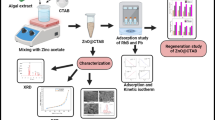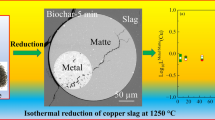Abstract
In this study, recycled Ni smelter slag has been used as a reactive medium for arsenic (As) removal from aqueous solutions. The results of the study showed that 10.16–11.43-cm long columns containing 451–550 g of slag operated for at least 65 days were able to remove 99–100 % As species from continuously flowing contaminated water at an initial As concentration of 10 mg/L. The removal capacities were found to be 1.039 to 1.054 mg As per g of slag. X-ray photoelectron spectroscopy (XPS) and Raman spectroscopy data also showed that electrostatic attraction and oxidation–reduction reactions between As species and mixed iron oxides present in the slag were the main mechanisms for the removal of arsenic from aqueous solutions. Theoretical multiplet analysis of XPS data revealed that the amount of goethite in the slag increased from 22 to 60 % during arsenic removal by adsorption and the percentage of magnetite decreased from 50 to 40 %. These changes indicate that redox-mediated reactions occurred as part of the As(V) removal process. Raman spectroscopy studies confirmed that, in addition to surface reactions, internal interactions between the slag and arsenic also occurred. The findings of the study suggest that recycled Ni smelter slag could be an effective low-cost reactive medium for a subsurface remediation system, such as a permeable reactive barrier. Recycling of waste material (slag) for the removal of another waste (arsenic) can significantly reduce the environmental footprint of metallurgical operations and hence contribute to sustainable development. Such recycling also decreases slag disposal costs and eliminates the need to purchase commercial reactive material or obtain expensive natural material for remediation purposes.











Similar content being viewed by others
References
Blowes DW, Ptacek CJ, Benner SG, McRae CWT, Bennett TA, Puls RW (2000) Treatment of inorganic contaminants using permeable reactive barriers. J Contam Hydrol 45:123–137
Choplelas A (1991) Single crystal Raman spectra of forsterite, fayalite, and monticellite. Am Mineral 76:1101–1109
Chowdhury SR, Yanful EK (2010) Arsenic and chromium removal by mixed magnetite-maghemite nanoparticles and the effect of phosphate on removal. J Environ Manag 91:2238–2247
Chowdhury SR, Yanful EK (2011) Arsenic removal from aqueous solutions by adsorption on magnetite nanoparticles. Water Environ J 25:429–437
Chowdhury SR, Yanful EK, Pratt AR (2011) Arsenic removal from aqueous solutions by mixed magnetite-maghemite nanoparticles. Environ Earth Sci 64:411–423
Chowdhury SR, Yanful EK, Pratt AR (2012) Chemical states in XPS and Raman analysis during removal of Cr(VI) from contaminated water by mixed maghemite–magnetite nanoparticles. J Hazard Mater 235–236:246–256
Chunming S, Robert PW (2001) Arsenate and arsenite removal by zerovalent iron: kinetics, redox transformation, and implications for in situ groundwater remediation. Environ Sci Technol 35:1487–1492
Cornell R, Schwetmann U (2003) The iron oxides: structure, properties, reactions, occurrence and uses. Weinheim, Willey-VCH, p 2003
Das S, Hendry MJ (2011) Application of Raman spectroscopy to identify iron minerals commonly found in mine wastes. Chem Geol 290:101–108
Fairley N (1999-2003) CasaXPS Version 2.2.19
Faria DLA, Venaüncio S, Oliveira MT (1997) Raman microspectroscopy of some iron oxides and oxyhydroxides. J Raman Spectrosc 28:873
Fendorf S, Eick MJ, Grossl P, Sparks PDL (1997) Arsenate and chromate retention mechanisms on goethite. 1. Surface structure. Environ Sci Technol 31:315–326
Grosvenor AP, Kobe BA, Biesinger MC, McIntyre NS (2004) Investigation of multiplet splitting of Fe 2p XPS spectra and bonding in iron compounds. Surf Interface Anal 36:1564–1574
Gupta RP, Sen SK (1974) Phys Rev 10:71
Gupta RP, Sen SK (1975) Phys Rev 12:15
Jia Y, Xu L, Fang Z, Demopoulos GP (2006) Observation of surface precipitation of arsenate on ferrihydrite. Environ Sci Technol 40:3248–3253
Kõyak B, OÈzer A, AltundogÏan HS, Tumen F (1999) Cr(VI) reduction in aqueous solutions by using copper smelter slag. Waste Manag 19:333–338
Kundu S, Gupta AK (2005) Analysis and modeling of fixed bed column operations on As(V) removal by adsorption onto iron oxide-coated cement (IOCC). J Colloid Interface Sci 290:52–60
Lee T, Benson C (2004) Using waste green sands for treating alachlor and metolachlor in groundwater. J Environ Qual 33(5):1682–1693
Lee SH, Jung W, Jeon BH, Choi JY, Kim S (2011) Abiotic subsurface behaviors of As(V) with Fe(II). Environ Geochem Health 33:13–22
Lo IMC, Lam CSC, Lai KCK (2006) Hardness and carbonate effects on the reactivity of zero-valent iron for Cr(VI) removal. Water Res 40:595–605
Metz S, Benson C (2007) Iron foundry slags as permeable reactive barriers materials for removing arsenic from groundwater, proceedings. GeoDenver, American Society of Civil Engineers
Mohan D, Pittman CU (2007) Arsenic removal from water/wastewater using adsorbents—a critical review. J Hazard Mater 142:1–53
Nikolaidis N, Dobbs G, Lackovic J (2003) Arsenic removal by zero-valent iron: field, laboratory, and modeling studies. Water Res 37:1417–1425
Pratt AR, Muir IJ, Nesbitt HW (1994) X-ray photoelectron and Auger electron spectroscopic studies of pyrrhotite and mechanism of air oxidation. Geochim Cosmochim Acta 58:827–841
Reuter M, Xiao Y, Boin U (2004) Recycling and environmental issues of metallurgical slags and salt fluxes. VII International Conference on Molten Slags Fluxes and Salts, The South African Institute of Mining and Metallurgy, 2004
Shen H, Wilson JT (2007) TCE removal from groundwater in flow-through columns simulating a PRB constructed with plant mulch. Environ Sci Technol 41:4077–4083
Sun X, Doner H (1998) Adsorption and oxidation of arsenite on goethite. Soil Sci 163:278–287
Vu KB, Kaminski MD, Nuñez L (2003) Review of arsenic removal technologies for contaminated groundwaters. ANL-CMT-03/2. Argonne National Laboratory 9700 South Cass Avenue Argonne, IL 60439
Welch AH, Westjohn DB, Helsel DR, Wanty RB (2000) Arsenic in ground water of the United States: occurrence and geochemistry. Ground Water 38:589–604
Wilkens J, Shoemaker S, Bazela W, Egler A, Bain J (2003) Arsenic removal from groundwater using a PRB of BOF slag at the Dupont East Chicago Site, Proc. RTDF PRBs Action Team Meeting, Niagara Falls
Yean S, Cong L, Yavuz CT, Mayo JT, Yu WW (2005) Effect of magnetite particle size on adsorption and desorption of arsenite and arsenate. Materials Research Society. J Mater Res 20(12):3255–3264
Zhang QL, Gao N-Y, Lin YC, Xu B, Le L-S (2007) Removal of arsenic(V) from aqueous solutions using iron-oxide-coated modified activated carbon. www.redorbit.com › News › Science
Zou J (2009) Tailored granular activated carbon preceded by pre-corroded steel. Ph.D thesis. Department of Civil and Environmental Engineering, The Pennsylvania State University
Acknowledgments
The research was funded by an Individual Discovery Grant awarded to E.K. Yanful by the Natural Sciences and Engineering Research Council of Canada (NSERC). The XPS and Raman spectroscopy work was performed in the laboratories of Surface Science Western.
Author information
Authors and Affiliations
Corresponding author
Additional information
Responsible editor: Bingcai Pan
Rights and permissions
About this article
Cite this article
Chowdhury, S.R., Yanful, E.K. & Pratt, A.R. Recycling of nickel smelter slag for arsenic remediation—an experimental study. Environ Sci Pollut Res 21, 10096–10107 (2014). https://doi.org/10.1007/s11356-014-2892-x
Received:
Accepted:
Published:
Issue Date:
DOI: https://doi.org/10.1007/s11356-014-2892-x




